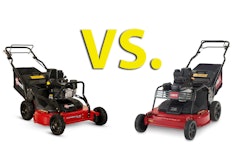
Early indications are that the new 30-inch commercial walk mowers introduced for this season by Toro and its subsidiary Exmark are being well-received by landscape contractors. In many cases, dealers are reporting better-than-expected sales with satisfied customers and few service issues.
"The (Toro) TurfMasters have been very well-accepted," says dealer Frank Fletcher of Fletcher's Sales & Service in Greensburg, PA. "(As of early-June) they were on back order for me."
Out in North Carolina, dealer Jerry Clay has also seen good sell-through of the TurfMaster. "We sold out of our initial shipment at both stores (Raleigh and Fuquay-Varina) and had more on back order in June," Clay relates. "When they come in, we have six landscapers committed to them. We've actually been looking for more of these mowers from other Toro dealers."
The Exmark Commercial 30 has also been a welcomed addition to dealer showrooms. "We've sold over 100," says Greg Pethel, store manager for Howard Brothers Equipment Company's Oakwood, GA, store. "Both landscapers and homeowners are buying them." Howard Brothers also has stores in Alpharetta, Doraville and Duluth, GA.
Over in Tyler, TX, dealer Maggie Cloete of Lawnmower Pit Stop has been pleased with her Commercial 30 sales, but is even more encouraged by future opportunity. "We only stocked one unit to start the season because so many of our landscape customers had just purchased new 21-inch Exmark walk mowers last year, and those last a couple of seasons. But we quickly sold our one Commercial 30 this spring and reordered five more, and those quickly sold too. Everybody who sees one wants one."
Fills a big void
Jonathan Beason of BA Lawn & Garden in Broken Arrow, OK (a Toro dealer), says the 30-inch walk mower has been long needed by landscape contractors. "We did very well with Toro's consumer version last year, the TimeMaster, which several contractors actually bought," Beason tells. "We received good reviews on that mower, so we were really excited heading into this year with an actual commercial-grade version in the TurfMaster."
Tim Oliver, outdoor power division manager for Howard Brothers, says the void filled by a 30-inch walk mower is the reason why the Exmark Commercial 30 is selling so well right out of the gate. "The gap between a 21- and 36-inch mower is so broad," Oliver says.
"The 30-inch mower gets the commercial customer a mower at a good price point, but more than fills the void between a 21-inch and 36-inch walk mower," adds Clay.
Effect on other walk mowers
Much like how stand-on mowers have taken some sales away from both intermediate walk mowers and zero-turn riders, one has to wonder what the 30-inch walk mower will do to its siblings.
"I expect most of our landscape customers to switch over from the 21-inch mowers because the 30-inch mower can really cut down on their labor," says Cloete. "And at just a $500 price difference, it makes a lot of sense.” Cloete is referring to the suggested retail price of the Exmark Commercial 30 vs. its commercial-grade 21-inch mowers.
Cloete also sees the 30 taking a bite out of 32- and 36-inch intermediate walk mowers. “These mowers are $3,100 to $3,500,” Cloete points out. “So the Commercial 30 (suggested retail price of $1,799) is a big cost savings, yet is very productive, durable and versatile.”
"One of the main reasons contractors like the Commercial 30 is the weight difference," Oliver says. "A 36-inch walk-behind is a lot heavier, so it rubs out the smaller properties when mowing the same path every week. The footprint is smaller on the 30, but the cut quality is equal to if not superior to a 36-inch hydro unit."
"We've had a lot of success selling the Toro TurfMaster to single-man landscape companies," says Beason. "But it has put a damper on our Toro 21-inch sales. We typically sold 50 to 70, but this year we've only sold 10. But we've sold 40 TurfMasters (by June)."
The TurfMasters are also putting a dent in Beason's intermediate walk mower sales. "Those things are struggling anyway, but now you can buy two 30-inch mowers for the price of one intermediate," Beason explains. "I've had opportunities to sell intermediates this season, but the contractor sees the TurfMaster and wants it."
Oscar Cavazos of MAE Power Equipment, an Exmark dealership in Mission, TX, doesn't see the 30-inch mower taking sales away from his 21-inch models. But he does see trouble for his 32- and 36-inch intermediates. "The price point of the 30-inch, along with its ability to get into back yards, are big pluses," Cavazos says. "The twin-blade design of the 30-inch mower is also nice."
Howard Brothers is still seeing sales plug along for both their 21-inch mowers and intermediates. "Just the other day I had a contractor buy an Exmark Commercial 30 but he also bought a 21," says Jeff Mitchell, manager of the Doraville store. Chris Chester, with the Alpharetta store, hasn't had much luck selling Exmark 21-inch mowers. But he has sold some Hondas. "I've also sold a good many Exmark 36-inch intermediates," Chester adds.
It's all about productivity
It just depends on what the landscape contractor needs. To them, it's all about uptime and productivity, and finding the right tool for the task at hand.
The 21-inch mower still has its place. For example, contractor Adam DeLoach, Oklahoma City branch manager for Tidewater Landscape Management, says a 30-inch mower might be "too much mower" in some residential settings. In others, it's just perfect.
"I had a contractor buy four Commercial 30s," says Matt Beverly, Alpharetta store manager for Howard Brothers. "The contractor does a cluster of homes. Every other week they push out 150 houses in this neighborhood. It used to take three guys with 21s. The first time they did it with 30s, they only needed two guys to do the same amount of houses in the same amount of time."
"I also had a contractor buy four Commercial 30s," Mitchell tells. "The contractor actually saved money. He'd been using 21s, but had an employee quit around the time he bought the 30s. They were able to lose no production time using the 30s with one less employee."
Sometimes, a more-productive piece of equipment can be the best employee money can buy.










![Gravely Pro Turn Mach One My23 Dsc03139 Edit 1200x800 5b2df79[1]](https://img.greenindustrypros.com/mindful/acbm/workspaces/default/uploads/2025/10/gravely-pro-turn-mach-one-my23-dsc03139-edit-1200x800-5b2df791.BucBnDoN22.jpg?ar=16%3A9&auto=format%2Ccompress&fit=crop&h=135&q=70&w=240)








